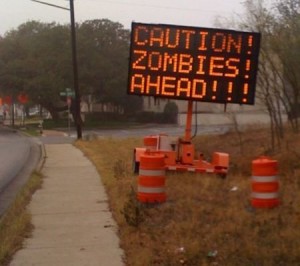Blueprint America — with The NewsHour with Jim Lehrer — in a story on how America’s highways are built and funded — often times at the expense of mass-transit development. Correspondent Rick Karr reports from Birmingham, Alabama.
What’s a Zombie Highway?
Rick Karr, Blueprint America correspondent
Let me answer that question with a hypothetical: Let’s pretend that the federal government has a program to help you improve your house or apartment. Lawmakers in Washington promise that for every dollar that you put up for construction, they’ll give you four dollars. It doesn’t matter how expensive the project turns out to be –- you’ll get four bucks in subsidies for every dollar that comes out of your own pocket. Until the project is finished.
In that case, would you ever have an incentive to finish your home improvement project? Or would the project keep shambling forward, like an extra in a George Romero film?
In the most recent Blueprint America piece for The NewsHour with Jim Lehrer, we report on a highway program that reform advocates say works exactly like the home improvement scenario.
The Appalachian Development Highway System was authorized by President Lyndon Johnson in the mid-1960s. The idea was to help nine Appalachian states build about 2,300 miles of highways to improve economic conditions in some of the poorest parts of the country. The federal government agreed to put up four dollars for every dollar the states would spend.
Forty-five years later, the program has expanded to 13 states, and more than 3,000 miles –- and counting. As environmental lawyer and highway-funding reform advocate David Burwell told us, under the system –- known as “cost-to-complete” –- states have an incentive to add more and more highways to the program, build them as expensively as possible –- and never finish them, because doing so would “turn off that federal spigot of money.”
Our case study is one of the newest additions to the Appalachian system: Birmingham, Alabama’s proposed Northern Beltline, a 52-mile stretch of interstate that would wind through the hills north of the city. The cost to taxpayers would be at least $3.327 billion dollars. The State of Alabama would put up its share of $665 million, while taxpayers from the other 49 states and the District of Columbia would cover the lion’s share of the remaining $2.662 billion.
Advocates for the highway say Birmingham needs it to boost economic development. They point to the growth that sprung up along the city’s southern beltline. They also argue that the new road would speed traffic through the region.
Opponents look at the growth along the southern beltline with horror, and argue that it’s exactly the opposite of what Birmingham needs. “We have built enough Interstates to kill our inner cities,” says Birmingham Mayor Larry Langford. “We don’t need more interstates. We’re going to need high speed public transportation. But we’re always spending our money in the wrong places.”


